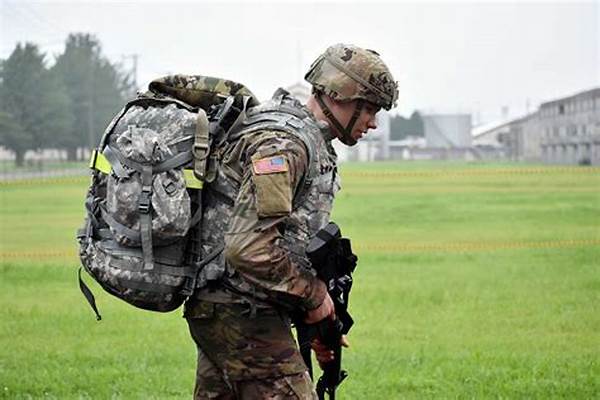The modern battlefield demands equipment that is both lightweight and durable to ensure optimal performance and safety for military personnel. As advancements in technology progress, the development of such equipment is essential to maintaining efficacy and protection in combat scenarios. Military forces around the world are increasingly prioritizing the need for gear that balances durability with reduced weight, facilitating improved maneuverability, and reducing fatigue among soldiers.
Importance of Lightweight and Durable Gear
The quest to develop lightweight and durable battlefield equipment is driven by the need for soldiers to carry their gear efficiently without compromising on effectiveness. Equipment that is cumbersome can severely impede a soldier’s agility and responsiveness in critical situations. Consequently, innovations in materials such as advanced composites and high-strength alloys are being employed to achieve the ideal balance between weight and ruggedness.
Another pivotal aspect in the design of lightweight and durable battlefield equipment is the assurance of protection. These tools and gear must withstand harsh environmental conditions and potential combat damage while still providing the necessary functionality. The advances in material science have allowed for protective gear and weapons systems that are not only robust but also reduce the overall burden on soldiers. As these developments continue, the emphasis remains on integrating technology that upholds the definition of battle-ready equipment that is both reliable and easily maneuverable.
Evolution of Material Technology
Lightweight and durable battlefield equipment is a product of significant innovations in material technology, allowing for the creation of items that do not compromise on strength. From the development of carbon-fiber composites to the use of advanced polymers, the materials chosen for military equipment are integral to achieving the desired performance and protection standards.
The integration of nanotechnology into material sciences has further revolutionized the production and enhancement of military gear, making it possible to fabricate incredibly resilient and lightweight items. This evolution underscores the commitment to providing military personnel with sophisticated tools that aid rather than hinder their operations.
By reducing the weight of battlefield equipment without sacrificing durability, military forces can ensure that their operational readiness is maintained at the highest levels, ultimately contributing to mission success.
Innovations in Design and Functionality
In the pursuit of lightweight and durable battlefield equipment, designers have focused on optimizing both form and function. The strategic incorporation of ergonomic designs allows for natural movement, ensuring that soldiers retain full mobility while carrying essential gear. Furthermore, the multifunctionality of certain equipment has been enhanced to reduce the overall load by eliminating the need for redundant items.
In recent years, modular systems have become prevalent. These systems allow for quick adaptation to varying combat scenarios, providing soldiers with the flexibility to tailor their gear according to immediate needs. This adaptability is a direct response to the dynamic nature of modern warfare, where efficiency and readiness can make a significant difference.
The marriage of innovative design and advanced materials continues to push the boundaries of what’s possible in the realm of military equipment, ensuring that the tools of today are in sync with the demands of tomorrow’s battlefields.
Key Features of Effective Equipment
1. Material Resilience: Lightweight and durable battlefield equipment relies on materials that resist environmental and mechanical stresses while ensuring longevity in use.
2. Weight Optimization: The reduction of weight without sacrificing necessary protective qualities is paramount for the enhancement of soldier mobility in combat situations.
3. Ergonomic Design: Equipment incorporating human-centric design principles ensures comfort, agility, and reduced fatigue during prolonged usage periods on the battlefield.
4. Modularity: The ability to reconfigure or augment equipment based on distinct mission requirements enhances operational flexibility.
5. Technological Integration: Advanced onboard technology within equipment facilitates real-time data collection and communication, supporting strategic decision-making processes.
Development of Personal Protection Gear
The advancement of lightweight and durable battlefield equipment extends significantly into the realm of personal protective gear. As the potential threats faced by soldiers grow more sophisticated, the protective armor they wear must also evolve. The integration of cutting-edge materials like graphene and ceramics enhances the protective capabilities of this gear while maintaining minimal weights.
Efforts to produce helmets, vests, and other forms of armor that provide superior ballistic protection continue to center on innovations that do not impose additional weight burdens on soldiers. The focus is on solutions that deliver comprehensive coverage and an adaptable fit, critically enhancing both safety and comfort in hostile environments.
Future Prospects and Challenges
The journey to refine lightweight and durable battlefield equipment faces several promising avenues as well as challenges. The continuous exploration of novel materials and cutting-edge design technologies will likely yield even more advanced solutions. However, balancing cost and production capabilities remains a challenge, necessitating strategic considerations to equate quality with accessibility.
Research and collaboration across defense agencies and private sectors will be critical to overcoming these hurdles. A concerted effort towards investment in research and development is required to ensure that the equipment provided aligns with future strategic needs. Prioritization of lightweight yet resilient solutions is paramount as defense landscapes persistently evolve.
In summary, the evolution of lightweight and durable battlefield equipment exemplifies the intersection of engineering, material science, and military strategy. The advancements made to date reflect a broader commitment to enhancing the effectiveness of modern military forces. As the landscape of warfare continues its rapid evolution, the provision of equipment that supports agility, resilience, and protection remains of utmost importance, enhancing the capabilities and safety of every soldier in the field.





